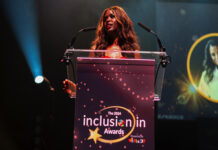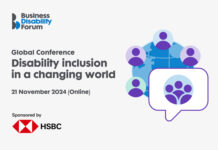It’s time to make digital designs more inclusive, urges the latest campaign #AllIWantForDigital, launched to coincide with the festive season.
The online campaign playfully adapts the festive phrase ‘All I want for Christmas is…’, to encourage others to tell their stories using the hashtag #AllIWantForDigital. Created by digital transformation agency Cyber-Duck, the campaign aims to show how accessible digital design improves the experience for everyone.
Supported by charities and digital trade associations such as Royal Association for Deaf People, Employers Network for Equality & Inclusion, LEXI, Phab, AbilityNet and BIMA, the #AllIWantForDigital campaign features disability campaigners, Paralympians, artists and TV personalities with visible and hidden conditions, sharing their lived experiences.
Former tech journalist Rory Cellan-Jones, TV presenter Mik Scarlet, comedy writer Sara Gibbs, author and campaigner Sandi Wassmer and gold medal Paralympian Giles Long are just some of the people living with disabilities featured in the campaign, who share why they want greater ‘digital’ inclusivity.
POOR DIGITAL ACCESSIBILITY
According to Cyber-Duck, poorly designed digital experiences mean that people with disabilities are often excluded. Over 22% of the UK population report a condition/disability, yet less than 3% of website homepages meet web accessibility guidelines. With the UK in the middle of a cost of living crisis, many products/services are only available cheaper online. But poor accessibility creates even bigger practical and economic barriers, especially for people with disabilities.
The campaign is urging organisations/brands to close the gap between good intentions and positive action by ensuring that their digital products/experiences are more inclusive and accessible.
Danny Bluestone, CEO and Founder of Cyber-Duck, which has led in digital accessibility since its inception in 2005, believes poorly designed digital experiences often excludes people with disabilities. “Tis the season to be jolly, not to worry about being excluded from digital activities many of us take for granted. Whether you are trying to pay utility bills online, order groceries, find gifts for friends and family, apply for a job or keep in touch over the holidays, no one should feel excluded because of poorly designed digital experiences, which are not inclusive,” said Bluestone. “Accessibility guidelines are a tick box activity for some. But we and our campaign partners want to see more positive action taken to design with inclusivity in mind, creating accessible experiences, which benefit everyone. Accessibility can’t be an after-thought and can’t be solved with plug-ins.”
INCLUSIVE DESIGNS FOR ALL
“All I want for Christmas is that those people who design or own a website or app to have a mindshift change. To stop thinking that they’re designing for disabled people or for those people over there and remember that good products work for everybody,” added Mik Scarlet, TV presenter, co-CEO Phab, and a wheelchair user.
Accessibility also just makes good business sense. If people find an app or website too difficult to use and navigate, they’re not going to stick around. Research from Purple Tuesday shows that in the UK, inaccessible websites cost retailers and businesses more than £411 billion throughout the pandemic. When apps and websites are accessible, it’s a win-win situation for both the users and the business.
ACCESSIBILITY TIPS
What does good accessibility look like? According to Cyber Duck, good accessibility is about:
- Providing customers with a choice. There is no “one size fits all” when it comes to accessibility. In fact, the needs of different user groups may even conflict with each other. Someone with low vision, for example, would appreciate bright colour contrasts. However, the same contrast level could reduce accessibility for someone who’s on the autism spectrum. In circumstances like this, giving users the option to adjust their settings or request information in a different format will enable them to choose an experience that works for their specific needs.
- Offer more than just accessible functions by providing accessible experiences. Supermarkets are doing the right thing in ensuring that screen readers can access their digital offers and promotions, making them available to a wider audience.
- Make sure you are continuously testing the app with a diverse range of people to verify that digital interfaces are solving day-to-day problems for everyone. Testing makes digital experiences better for all, including the ‘typical’ majority who think they don’t (yet) have accessibility needs. It empowers everyone to digest digital content in whatever way they choose to suit their needs and circumstances; whether that’s via Alexa, while jogging, or in languages that aren’t their mother tongue.
- Focus on user centred design. Ensure to design apps and websites with inclusivity in mind, creating accessible experiences for all.





































